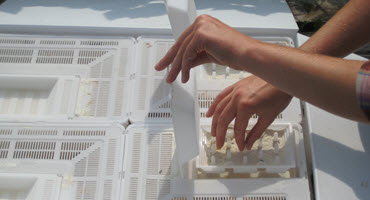Good things happen when bees meet this homegrown biological agent technology
by Owen Roberts
A unique pest control approach called apivectoring, which traces its roots in Canada to the University of Guelph (U of G), is drawing industry attention after recently receiving approval for producer use in the United States.
Apivectoring, also called bee vectoring, is a crop protection system that uses bees from managed hives as a transport mechanism (or vector) for products such as biological agents that suppress pests on crops.
Using this approach, pollinators provide what Dr. Peter Kevan, U of G’s apivectoring pioneer, calls a “double benefit to agriculture” – that is, crop pollination and crop protection acting together to increase yields and quality.
Earlier this year, an approach that’s been in the testing and approval stages for nearly a decade by Bee Vectoring Technologies (BVT Inc.) received the first approval for a commercial food crop protection product applied to flowering crops by live bees.
The U.S. Environmental Protection Agency (EPA) granted approval for Clonostachys rosea CR-7, an organic fungicide used on commercial food crops such as strawberries, blueberries, sunflower and almonds.
BVT Inc., the Canadian company that commercialized the technology, says large-scale commercial demonstrations carried out on strawberries in Florida showed the apivectoring system delivered comparable, if not improved disease protection, over sprayed chemicals. The system also showed yield increases.
Initial experimental field research at the University of Guelph in the late 1980s demonstrated similar benefits. Those results, coupled with further trials, spurred on this technology to commercialization.
EPA approval is seen as a major step forward for BVT Inc., which hopes to have a green light for use of this technology in Canada in 2021.
“Not only is this a critical milestone for BVT Inc. in terms of the commencement of scalable commercialization and revenue, but it represents a groundbreaking shift in how plant care products can be applied,” said Ashish Malik, CEO of BVT Inc.
“By using commercially reared bees to deliver biological products, growers can protect crops, increase crop yields and enhance their sustainable growing practices by reducing the use of chemicals and other costly and increasingly scarce resources including water, fuel and labor.”
Here’s how bee vectoring works.
Replaceable trays containing granular forms of control agents that are not toxic to bees, such as certain organic fungicides and insecticides, are placed at the mouth of the hive.
To leave the hive, bees must traipse across the trays. When they do, they naturally pick up whatever control agent the trays contain. The agent sticks to the bees’ bodies, but it doesn’t impede their flight.
Ultimately, the bees land on the targeted crop’s blossoms or flowers and crawl over them. As the bees move, the control agent is released onto the blossom or flower. In that way, the pests (insect or fungi) are exposed to the control agent which does its work in suppressing their adverse effects.

These trays contain the crop protection product the bees will carry to the fields.
The technology goes back to the 1980s, when Guelph environmental biologists Kevan and Dr. John Sutton were looking for novel ways to deliver biological fungicides to plants.
They knew pollinating and flower-visiting insects can carry and spread disease. So, they figured that maybe insects could be employed to prevent disease by distributing natural fungicides instead.
“The idea that biological control agents could be dispersed by flower-visiting insects is hardly new, if you consider that pollination itself involves the dispersal of the biological control agent of fertilization – pollen – for most flowering plants,” said Kevan.
A key development occurred when Sutton discovered a beneficial fungus in a strawberry field just outside Guelph. When this fungus is introduced to plant tissue, it colonizes and takes up the same space that certain pathogenic fungi would occupy. As a result, the harmful fungi don’t get a chance to take a foothold.
Challenges followed as the pair worked with colleagues to develop effective on-hive dispensers and carrier agents for the fungus, as part of an initiative called the B52 project. Some carriers irritated the bees; some even proved fatal. Other carriers were ineffective at holding the beneficial agent.
But the researchers didn’t give up. Pest and disease outbreaks, such as the tarnished plant bug infestation in canola in Alberta in 1992, helped focus Kevan’s efforts towards insect pest suppression. Collaborations between Kevan and Sutton expanded through the work of their teams and with Less Shipp on insect control at Agriculture and Agri-Food Canada’s greenhouse research facilities.
With support from the Natural Sciences and Engineering Research Council, Kevan went on to refine the carrier agent and invent a removable, replaceable biocontrol agent tray. It’s based on a pollen dispenser design that dates to the early 1940s from the Nova Scotia Agricultural College, now the Truro campus of Dalhousie University.
His design was later refined by BVT Inc. after the company acquired the rights in 2012 to develop the discovery into a commercial product.
Now, with BVT Inc. behind the technology, it looks ready to soon take hold on farms throughout North America.
Kevan is optimistic about its potential.
“It’s taken over 35 years to get from concept through to commercialization,” said Kevan. “But pollinator-vector technology brings together the benefits of pest management, reduced chemicals, less fuel for machinery and water use, and better pollination for the crop, which results in higher yields and better crop quality.”
So, what’s not to like?